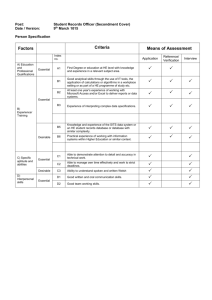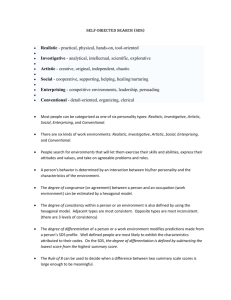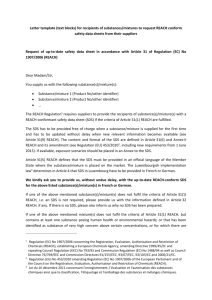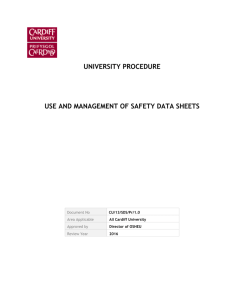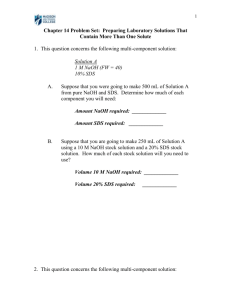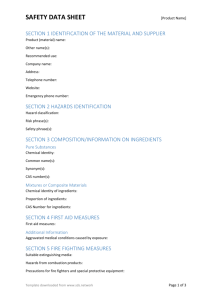Chemical Standard Operating Procedure Template
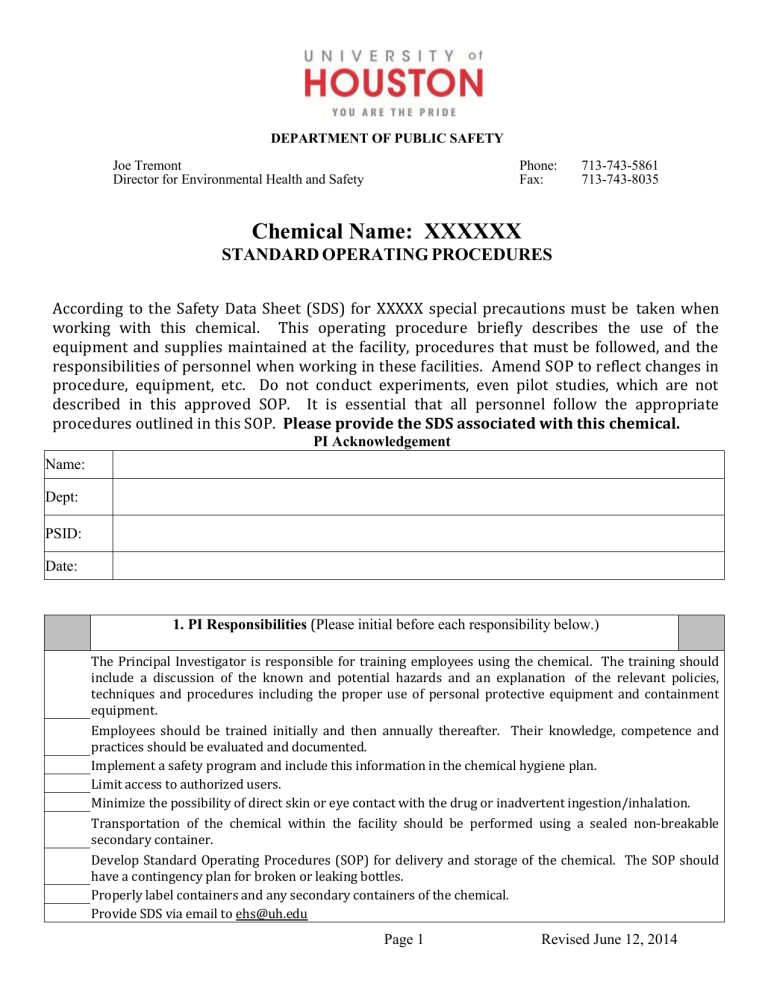
DEPARTMENT OF PUBLIC SAFETY
Joe Tremont
Director for Environmental Health and Safety
Phone: 713-743-5861
Fax: 713-743-8035
Chemical Name: XXXXXX
STANDARD OPERATING PROCEDURES
According to the Safety Data Sheet (SDS) for XXXXX special precautions must be taken when working with this chemical. This operating procedure briefly describes the use of the equipment and supplies maintained at the facility, procedures that must be followed, and the responsibilities of personnel when working in these facilities. Amend SOP to reflect changes in procedure, equipment, etc. Do not conduct experiments, even pilot studies, which are not described in this approved SOP. It is essential that all personnel follow the appropriate procedures outlined in this SOP. Please provide the SDS associated with this chemical.
PI Acknowledgement
Name:
Dept:
PSID:
Date:
1. PI Responsibilities
(
Please initial before each responsibility below.)
The Principal Investigator is responsible for training employees using the chemical. The training should include a discussion of the known and potential hazards and an explanation of the relevant policies, techniques and procedures including the proper use of personal protective equipment and containment equipment.
Employees should be trained initially and then annually thereafter. Their knowledge, competence and practices should be evaluated and documented.
Implement a safety program and include this information in the chemical hygiene plan.
Limit access to authorized users.
Minimize the possibility of direct skin or eye contact with the drug or inadvertent ingestion/inhalation.
Transportation of the chemical within the facility should be performed using a sealed non-breakable secondary container.
Develop Standard Operating Procedures (SOP) for delivery and storage of the chemical. The SOP should have a contingency plan for broken or leaking bottles.
Properly label containers and any secondary containers of the chemical.
Provide SDS via email to ehs@uh.edu
Page 1 Revised June 12, 2014
2. Chemical Information
⎕ Form of chemical used: (solid, liquid, gas)
⎕
⎕
Supplier of chemical: (example; company name, web address)
Name of Chemical:
⎕CAS Number:
⎕Hazard Classification: Write HMIS table from Safety Data Sheet (SDS). If HMIS data is unavailable, write in Globally Harmonized System (GHS) classification data from SDS.
3. Toxicological Information
⎕ Acute Effects: Use the information from the SDS.
⎕ Chronic Effects: Use the information from the SDS.
⎕ Describe Potential Health Effects: Use the information from the SDS.
4. Detailed Description of Proposed Work
⎕Describe Experiment:
⎕Describe reconstitution procedures including the use of lab-ware (syringes, pipettes, beakers, sharps,).
⎕Describe training, supervision, access restriction of lab workers to minimize chemical hazard exposure.
⎕Where in the lab, are reagent preparations and or reconstitutions performed? (fume hood, biosafety
cabinet, bench top)?
⎕Where in the lab, are stock chemicals, prepared reagents and/or working solutions stored?
Provide information below (if applicable).
⎕What is the animal administration dosage?
⎕How long will the animal receive the dosage?
⎕Approximately how many animals are in the experiment?
⎕If not explained in the experiment description, detail how and where dose will be administered.
5. Handling Instructions
⎕ Describe handling instructions mandated in the SDS. Include incompatible chemicals and conditions.
⎕ Describe additional handling instructions specific to the experiment.
6. Disposal Instructions
⎕ How are surplus chemicals and working solutions properly disposed?
⎕ Where will needles and sharps be properly disposed?
For Animal Experiments
⎕ How and where will carcasses be disposed?
⎕ How will animal bedding be disposed?
⎕ How will surplus liquid chemical in the administration device (syringes, needles, pipettes) after dosage be disposed?
7. Personal Protective Equipment
⎕ Describe PPE to be used. Include in the description, EHLS required PPE and PPE mandated by the SDS that will be used. Please include a description of the type of glove material that will be used.
8. Engineering Controls
⎕ What engineering control will be used for reconstitution and or reagent preparations? Where is its
⎕ location in the laboratory?
If applicable, describe any other engineering controls used. Where is its location in the laboratory?
For animal experiments:
⎕ What engineering control will be used during animal dose administration? Where in the lab will the engineering control be located?
Page 2 Revised June 12, 2014
9. Preparation of Chemicals Used
⎕ Define all the components of the mixture:
⎕ Define dilution methods and procedures, include amounts:
⎕ Provide final concentration on chemicals used:
10. Exposures (e.g. ingestion, skin contact, inhalation, etc.)
⎕Describe the methods to prevent exposures and or control routes of entry. See SDS and specific good
laboratory practices.
⎕Describe first-aid measures for inhalation, skin/eye contact and ingestion. Information on SDS.
⎕Specify location of the nearest emergency eyewash station and safety shower.
11. In Case of Spills
⎕ Describe precautions to take regarding a spill.
⎕ Small Spills - less than 5 gallons: Describe small spill procedures and include how to dispose of material.
⎕ Large Spills - more than 5 gallons: Describe large spill procedures and include how to obtain assistance
⎕ from EHLS and UH Police.
List the contents and the location of the laboratory spill kit.
12. Animal Use “If Applicable”
⎕ Provide IACUC protocol #________________________________
⎕ Label cages with chemical agent, date of dosage and dosage amount.
⎕ Place carcass in leak-proof red bags and transport to “Carcass” freezer.
13. EHLS Policy Requires
EHLS policy requires that all chemical hazards must be clearly identified. If you have any questions regarding risk assessment and SOP development, contact the EHLS office 713-743-5858 or ehs@uh.edu
This plan must be supplemented with the laboratory’s Chemical Hygiene Plan and must include special practices when working with a particular chemical and the SDS must be accessible. Also, all laboratory personnel must be familiar with safe handling practices (i.e., training with proof of training).
The University’s Chemical Hygiene Plan is located at http://www.uh.edu/ehs/manuals_and_forms/manuals_Chem_Hygiene.pdf
.
PI Acknowledgement
Name:
Signature:
Office Phone:
E-Mail:
Date:
Cell
Phone:
Name:
Name:
Name:
Name:
Name:
Name:
Trained Laboratory Personnel:
E-Mail:
E-Mail:
E-Mail:
E-Mail:
E-Mail:
E-Mail:
EHLS Reviewer: Date:
Page 3 Revised June 12, 2014

